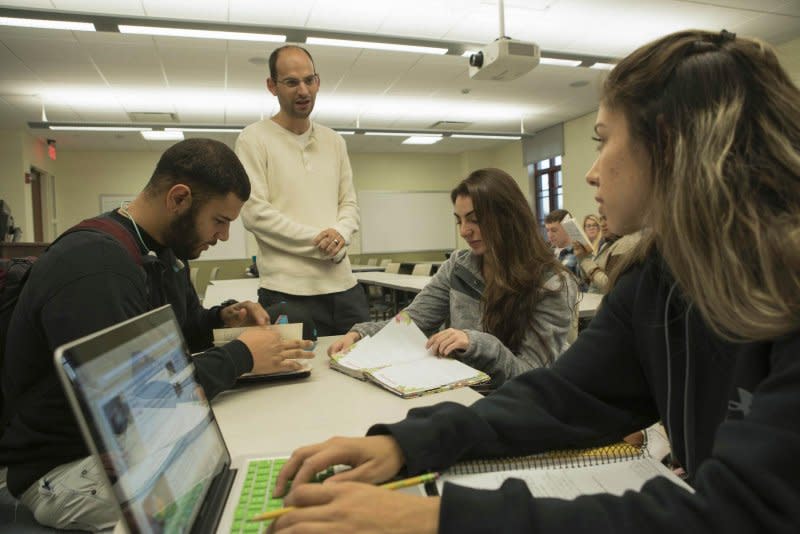Gen Z perceives more dangers than previous generations, study shows

NEW YORK, Dec. 13 (UPI) -- Members of Gen Z -- those born from the late 1990s to the early 2010s -- perceive more dangers in life than previous generations, a study reveals.
The new research, to be presented Wednesday at the 2023 Society for Risk Analysis Conference in Washington, D.C., indicates that young peoples' inability to comprehend risk is a critical component of the mental health crisis that engulfs their generation.
To probe this issue, Gabriel Rubin, a professor in the Department of Justice Studies at Montclair State University in Montclair, N.J., conducted 50 interviews with members of Gen Z.
The ongoing study examines risk factors that have led to the current mental health crisis in young people. So far, it has identified risk factors such as mass shootings, school lockdown drills, parental pressure, social media and the climate crisis as key.
"Despite risk analysis research demonstrating that we live in one of the safest times ever, Gen Z experiences a disparity in risk assessment from their older counterparts, essentially having the perception that risk is everywhere they turn," according to a news release about the study.

One of the key findings from Rubin's interviews is that members of Gen Z are inundated with a constant stream of news alerts that overemphasize their threat level. They are presented with a world in which risk is black and white -- that things are safe or pose dangerous risk.
Previous research has shown that risk is not black and white -- many risks exist in life and they can be weighed, yet Gen Z members regard risk as either the presence or absence of safety in a situation.
The new research has revealed that the disparity in risk assessment has resulted in many young people feeling anxious, depressed and even suicidal, particularly young girls and women. It notes that messaging to Gen Zers should emphasize that a significant gray area exists in risk and in life.
"One of the big questions people have is whether this spike in anxiety and depression is due to there being less of a stigma, which allows people to talk about it more, or whether there are other factors going on that have led to these higher incidences. That's what drove me to do these interviews," Rubin told UPI in a telephone interview.
"There's a lot of misperception about young people today. A lot of people think that they are overreporting these issues or that they shouldn't be feeling this way," he said, adding that some people perceive them to be overly sensitive. But that's not what he encountered.
On a daily basis, Gen Z members are "faced with anxiety-inducing or depressing experiences," Rubin said, citing the COVID-19 lockdowns as an example.
In another common scenario, he noted that this population grapples with the someone bringing a real weapon to school learning it was a false alarm. Climate change also looms large on their minds, and they dread it.
"They're taught from a young age that the world is ending -- that climate change is going to destroy the planet and that no one is going to do anything it," Rubin said.
This generation came into the world at a time of significant stressors. including spikes in unemployment and the opioid epidemic, which took a toll on their families, Dr. Larry Wissow, a professor and head of the division of child and adolescent psychiatry at the University of Washington School of Medicine in Seattle, told UPI in a telephone interview.
The impact of such trauma can alter mechanisms in the brain that respond to stressors in the environment, Wissow said, adding that "we have a generation of young people who were born at a time of adversity, and it makes sense that they would have an altered sense of threat."
Tania Czarnecki, a licensed psychologist and executive director of counseling at Drexel University in Philadelphia, told UPI via email that the research conducted by Rubin "is attuned to what our young folks are facing today."
"Our young folks are in quite a predicament, in terms of coming of age during a troubling time while also needing to find balance and live physically and mentally healthy lives," Czarnecki said.
"They have already faced a pandemic, mass shootings, social injustice, threats to our Black, Indigenous, and people of color population, LGBTQIA+ folks, cyber bullying, climate change, a deeply polarized country -- all while trying to navigate the constant bombardment of unfiltered social media."
David Cates, a licensed psychologist and director of behavioral health at Nebraska Medicine in Omaha, told UPI via email that Gen Z members' assessment of risk may be different than that of other generations.
That's because they are dealing with "poorer mental health, concern for their safety, and financial stress, along with a high level of social media use in which these concerns are often amplified," Cates said.
Leah Orchinik, a pediatric psychologist at Nemours Children's Health in Wilmington, Del., told UPI via email "exposure to and consumption of news is ubiquitous in the era of social media, with Gen Z being digital natives who have grown up with continuous access.
"This inundation can mislead people to believe that the rates of negative and/or threatening current and world events are higher than they are, because the exposure to coverage of them is constant," she said.

